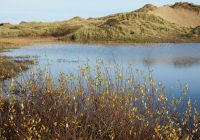Dr Phil Smith’s Wildlife Notes
November 2012
Frequent deluges during the month brought a welcome return to “Lake District” conditions in the sand-dune slacks, Devil’s Hole, in particular, starting to look like a swimming pool, while the extensive slacks at Ainsdale Sandhills Local Nature Reserve epitomised E.R. Beattie’s mid-19th century description:
“After the autumn rains little lakes, locally called slacks, were formed; sometimes slack after slack, separated from each other by narrow bars of sand, stretched in a long chain for great distances, each one reflecting the yellow slopes of the dunes and the blue sky above. And then as night approached they were none the less beautiful, as standing on some hill and looking seaward one beheld a long line of hills dark and purple, their serrated edges sharply cut against the sunset sky of amber and gold and shimmering tender greens and opalescent greys and blues, all repeated in the still waters of the miniature lakes.”
The Sefton Coast has over a third of all the dune slacks in England. They represent a key wildlife habitat, supporting some of our rarest animals and plants. Apart from drought, the main threat to them is scrub-invasion. Last year, with Patricia Lockwood, I started cutting and pulling young Sea Buckthorn which was re-colonising botanically-rich slacks near Sands Lake that had been cleared in the 1990s. Friends indicated they would like to help, so as volunteers under the auspices of Sefton’s Landscape Partnership Scheme, we organised three “buckthorn bashes” during the month, between six and eleven people turning out. We really gave that Buckthorn something to think about!
November is usually a good month for snipe but a visit to Cabin Hill on 17th produced only 14 Common Snipe and one Jack Snipe where several times that number have been seen in previous years, so perhaps the floods were too deep for these waders. However, a couple of Water Rails enlivened proceedings with their “squealy pig” calls and I nearly trod on a well concealed Pink-footed Goose, presumably sick or injured, though it managed to beat a hasty retreat towards the mosslands.
A few insects were still about in the early part of the month, Rachael Parks reporting a Peacock butterfly in her Formby garden on 4th. The following day, I had a Common Darter at Devil’s Hole but this date was easily beaten by one at Brockholes, near, Preston, on 23rd. Dave Hardaker tells me he found two hatchling Sand Lizards on 11th, the latest he has ever seen.
I was pleased to find Comma and Red Admiral on the Ravenmeols ivy on 11th, when there were still large numbers of hoverflies on this important autumnal nectar source. Nearby, the usual tit flock also held a Tree Creeper, always nice to watch scurrying up the tree trunks. The ornithological highlight of the month, however, was an influx of Waxwings to Formby, flocks of up to 60 of these colourful Scandinavian visitors being seen, mainly on Rowan berries for a few days in mid-month. The main centre of activity was the estate around Harington Road where I found them elusive but managed to catch up with 14 birds on 15th.
A rare sunny day on 21st found me on the National Trust beach where recent high tides have revealed layers of hardened silts containing more of the famous Formby footprints. Although not particularly clear, there are lots of them dating back many thousands of years to the late Mesolithic age. Some may be contemporary with the nationally important prehistoric settlement recently excavated at Lunt Meadows on the River Alt and featured on a BBC TV “Inside Out” programme. An extract from this programme can be accessed at http://www.bbc.co.uk/news/uk-england-20344575
More good news from further afield came when Chat Moss, Greater Manchester, was saved from further peat extraction, the Government confirming refusal of planning permission after a public inquiry. The importance of peatlands for carbon storage is now well established and the Lancashire Wildlife Trust is promoting the restoration of this area for wildlife, complementing its existing mossland reserves in the area.




